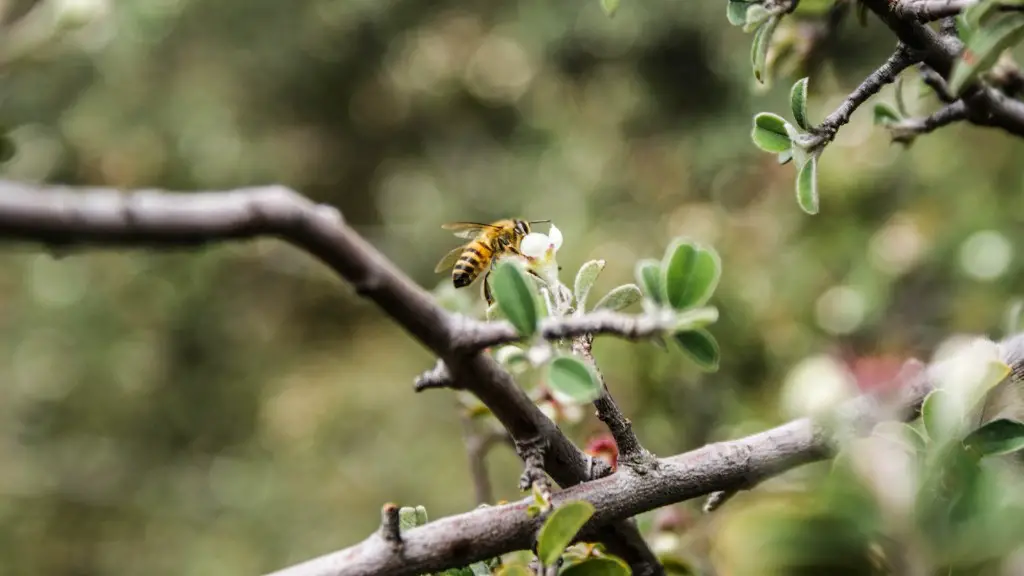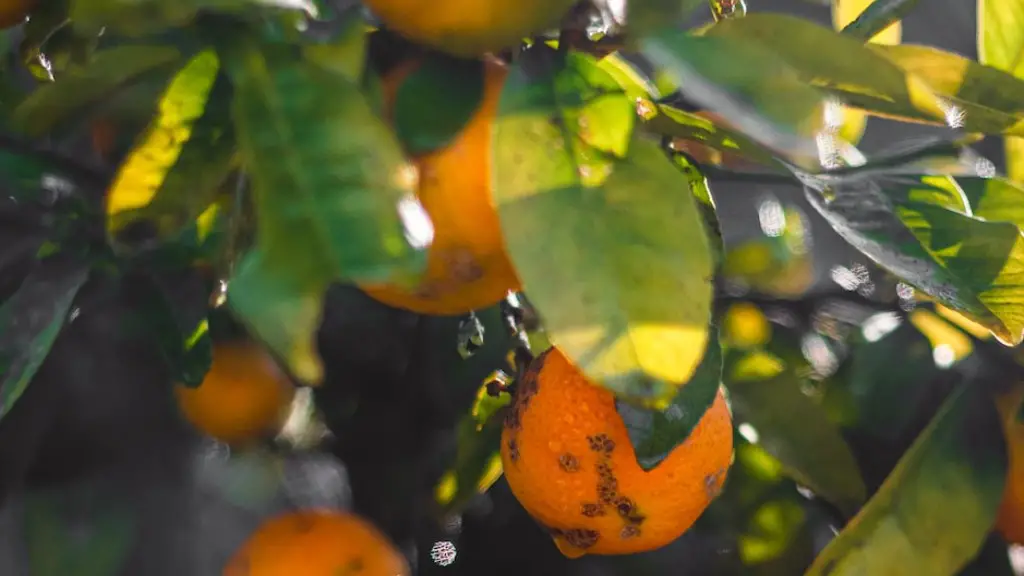A single apple tree can produce an abundance of apples in a single year. On average, an apple tree produces approximately 40 to 300 apples per season depending on the type of apple tree, cultivation techniques and how well the tree is cared for. Additionally, many apple trees produce pulp, which can also be used to make cider.
The number of apples produced by a single tree vary depending on the health and maturity of the tree. A mature apple tree that is well cared for can produce up to 300 apples in a single season, with the average tree producing around 40 to 120 fruits.
Younger apple trees will still produce apples, however, the size of each fruit is smaller and the overall yield is reduced. Also, if the tree is not well cared for and receives a lack of water and nutrition it may struggle to produce any fruit at all.
The type of apple tree will also play an integral role in determining the yield. Certain apple cultivars are known to thrive in certain climates, while others grow more slowly. Some of the popular and disease-resistant apple cultivars, such as Honeycrisp and Fuji, produce upwards of 200 apples yearly when grown in the right environment.
Apple trees require extensive irrigation and pruning also influence the amount of apples that are produced. If the tree is given too much water, the fruit will be of a lesser quality, so it is important to give the tree the right amount of water to ensure that a high-quality yield is produced. Pruning is also essential to maintain the tree’s health and encourage new growth.
Successful apple cultivation requires knowledge of the tree, the climate and proper care. By understanding the factors which influence apple production, apple growers can optimize their production and reap the rewards of a bountiful harvest.
How to Care for an Apple Tree
Apple trees require dedicated care and attention in order to produce a plentiful harvest every year. Temperature, soil and water levels all play a role in the health of an apple tree and must be managed to ensure the tree’s health and quality of apples.
Soil preparation is essential to growing a healthy apple tree. In order to grow well, apple trees need a slightly acidic, loose soil that drains well. To achieve this, they must be planted in a site with full sun exposure and the soil must be amended with organic matter such as compost.
Irrigation is the key to a successful apple harvest. Too much or too little water can damage the trees and reduce the tree’s output. Apple trees require between 2-4 inches of water per week and can be watered using an irrigation system or by hand.
Pruning is also an important part of apple tree care. A mature apple tree should be pruned once or twice per year to remove dead or diseased branches, promote new growth and increase air circulation.
The best way to ensure a healthy harvest is to be proactive when caring for an apple tree. Regular planting, fertilization, pruning and pest control is essential to ensure a healthy tree and quality produce.
Which is the Best Apple Tree To Grow
When choosing an apple tree for a home garden, there are many factors to consider. Firstly, the apple tree should be suited to the local climate and soil. Apple trees are classified into three main categories, with each type requiring different levels of care and conditions in order to thrive.
The most popular type of apple tree is the “dwarf”. Dwarf apple trees are small, usually reaching a mature height of 8 to 15 feet, and produce the same type of fruit as a standard apple tree. They require minimal pruning and are generally disease-resistant, making them a good choice for beginner gardeners.
The next type of tree is the “semi-dwarf”. This type of apple tree produces larger fruits than the dwarf trees, but require more maintenance and are more prone to disease. They are larger than dwarf trees, reaching a mature height of around 15 to 20 feet.
The last type of tree is the “standard”. These trees are the largest and produce the most fruit. They reach a mature height of up to 30 feet but require more pruning and maintenance to remain healthy and produce a good harvest.
When choosing an apple tree, consideration should also be given to the type of apple desired. A wide variety of types of apples exist, ranging from sweet to tart and ranging in colors from yellow to dark-red. Each of these different types of apples have different characteristics and grow best in different climates.
For beginner gardeners, a dwarf tree is the best choice. It will produce a large yield of apples and will require minimal care and maintenance. For experienced gardeners, a semi-dwarf or standard apple tree offers greater rewards with more maintenance and care.
What Conditions are Needed for Apple Trees to Thrive
In order for apple trees to thrive, certain environmental conditions need to be met. Apple trees prefer full sun exposure and a slightly acidic soil. Additionally, the soil should be well-draining and must be amended with organic matter such as compost to ensure the tree’s health.
Irrigation is also essential to ensure that the tree receives the water it needs. Apple trees need an average of 2-4 inches of water per week for optimal growth.
In addition to sun and water, apple trees also require consistent temperature and humidity levels. Extreme temperatures and regular weather fluctuations can reduce the yield of apples, so it is important to consider this when deciding where to plant an apple tree.
Pests are another factor to consider when planting an apple tree. Common apple tree pests include woolly apple aphids and apple maggots. Regularly monitoring for pests can help to reduce damage to the tree and ensure a healthy harvest.
Apple trees are a rewarding and relatively easy crop to grow, provided the proper conditions are met. By taking the time to prepare the soil, control pests and irrigate, gardeners can reap the rewards of a bountiful harvest.
What Are the Alternatives to Growing Apple Trees
Growing apple trees is not always a viable option. For those living in areas with unfavorable weather patterns, disease prone soils, or limited space, there are alternatives available.
For those in cooler climates, consider growing hardier flowering trees such as cherries, peaches, and plums instead. These trees require less care and maintenance than apple trees, and will often tolerate cold temperatures better.
Those with limited space or irregular shapes to their yard should look into growing dwarf trees or container gardens. Dwarf trees are smaller versions of full-sized apple trees and can produce a good yield with less maintenance and care. Many fruits, including apples, can be grown in containers and can provide a great harvest in less space.
For those living in an urban environment, there are many options for growing fruit trees or small fruits in a limited space. Container gardens can be used to grow apples, strawberries, and many other types of small fruits. Alternatively, dwarf trees can be planted in small yards or on balconies and will still produce a good yield.
For those unable to grow traditional apple trees, there are still many options available. Growing container gardens, dwarf trees, and hardier fruits are all viable alternatives that can still provide a good harvest.
What Are the Benefits of Growing Apple Trees
Apple trees offer many benefits to those who wish to grow them. Firstly, apple trees are relatively easy to care for and can produce a large yield of fruit each year. Apples are also a healthy and nutritious fruit, high in fiber, vitamins and minerals.
Apple trees are also beneficial to wildlife. bees and other pollinators are essential for apple production and attract a variety of beneficial insects. Planting an apple tree in a garden is also beneficial for birds, which feed on the apples once ripe and use the tree for shelter from the elements.
Apple trees are also beneficial for those looking to create a sustainable lifestyle. Apples can be used for a myriad of recipes, from pies and tarts to wine and juices. Apples can also be stored in a root cellar or dehydrated and stored for future use.
Finally, apple trees are beneficial to the greater environment. Reducing our reliance on store-bought produce is one of the key aspects of a sustainable lifestyle, and growing one’s own fruit is a great way to do this. Apples can also be used for compost, reducing the amount of waste sent to landfills.
In conclusion, apple trees are a rewarding and beneficial crop to grow. From their nutrition content to their environmental benefits, apple trees offer something for everyone.

